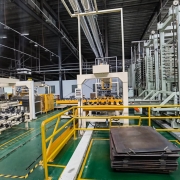Hoe kies je de juiste sjabloon voor je SMT-behoefte?
Hoe kies je de juiste sjabloon voor je SMT-behoefte?
Als je van plan bent om een stencil te maken voor een Surface Mount Technology project, dan moet je bekend zijn met een aantal factoren die je kunnen helpen bij het kiezen van de stencil die je nodig hebt. Deze factoren zijn prijs, vorm en afmeting. Als je met deze factoren rekening houdt, kun je de beste keuze maken.
Afmetingen
Een stencil moet de juiste afmetingen hebben om de bordgegevens erop te kunnen plaatsen. Dit wordt het effectieve gebied genoemd. Dit is het centrale gedeelte van de sjabloon dat gesneden kan worden om op de aansluitpinnen van de SMT-kaart te passen. De resterende ruimte rond de stencil wordt de stencilmarge genoemd. De stencil kan niet verder gesneden worden dan dit gebied.
Er zijn vijf belangrijke soorten SMT-stenciltechnologieën. Deze omvatten lasergesneden, elektrisch gevormd, chemisch geëtst en hybride. Chemisch geëtste metalen sjablonen zijn erg handig voor step sjablonen. Deze stencils worden aan beide zijden chemisch gefreesd en het resultaat is een bijna rechte wand met een lichte zandlopervorm in het midden.
Textuur
Er zijn veel opties als het gaat om sjablonen. Je kunt stencils kopen of ze zelf maken. Een stencil is een ontwerp dat is uitgesneden met een plotter. De kwaliteit en de grootte van het sjabloon hangen af van de instellingen van de plotter. Zorg ervoor dat de kracht- en snelheidsinstellingen juist zijn voordat je een stencil uitsnijdt. De kracht moet voldoende zijn om door het vinyl te snijden zonder de kleverige achterkant te beschadigen. De snelheid moet snel genoeg zijn om de sjabloon zo snel mogelijk uit te snijden. Als je echter te snel snijdt, kunnen de hoeken van de rechthoeken scheuren.
De stencils die gebruikt worden in de surface mount technologie zijn meestal gemaakt van roestvrij stalen folie. Ze worden met een laser op maat van het opbouwapparaat gesneden. Deze sjablonen worden op de printplaat geplaatst en gebruikt om soldeerpasta aan te brengen. Het stencil zorgt voor een nauwkeurige plaatsing van de soldeerpasta zonder dat er handenarbeid aan te pas komt. Bovendien bespaart een stencil tijd en moeite.
Prijs
Bij het kopen van stencils moet de klant erop letten om er een te vinden die geschikt is voor zijn/haar vereisten. Er zijn twee belangrijke factoren om rekening mee te houden: de dikte van de sjabloon en de gegevens van de printplaat. De dikte van de sjabloon helpt om de pasta los te maken van de printplaat. Bovendien moet de sjabloongrootte binnen het Effectieve Gebied (EA) vallen, dat is het centrale gedeelte van de sjabloon. De rest van het stencil wordt de marge genoemd en kan niet worden afgesneden.
De grootte van het stencil is een belangrijke parameter voor elke automatische soldeerpastaprinter. Verschillende PCB's hebben verschillende interne afmetingen en de sjabloon moet aangepast zijn aan de framegrootte van de printer.
Beschikbaarheid
Stencils zijn een uitstekende optie voor verschillende decoratieprojecten. Of je nu een kamer schildert of een uniek ontwerp toevoegt aan een meubelstuk, stencils kunnen zorgen voor een schoon, scherp beeld. In tegenstelling tot een verfkwast zijn stencils herbruikbaar en gaan ze jaren mee.

